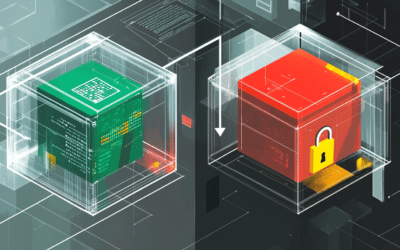
Dynamic Data Subsetting – The Power of Data Cloning
MAY, 2023
by Jane Temov.
Jane Temov is an IT Environments Evangelist at Enov8, specializing in IT and Test Environment Management, Test Data Management, Data Security, Disaster Recovery, Release Management, Service Resilience, Configuration Management, DevOps, and Infrastructure/Cloud Migration. Jane is passionate about helping organizations optimize their IT environments for maximum efficiency.
In the age of big data, managing and harnessing vast amounts of information efficiently has become a critical challenge for organizations across various industries. As datasets continue to grow exponentially, traditional approaches to data management and analysis often fall short, leading to increased storage costs, slower processing times, and cumbersome workflows.
One powerful technique that has emerged to address these challenges is dynamic data subsetting, leveraging the capabilities of data cloning. By creating lightweight copies of data that track only the changes or modified information, dynamic data subsetting offers a flexible and efficient solution for managing large datasets on the fly.
The essence of dynamic data subsetting lies in its ability to capture and utilize only the necessary subset of data, eliminating the need to duplicate and process the entire dataset. This approach not only optimizes storage utilization but also enhances data access and analysis performance by focusing on the specific information relevant to a given use case.
The cornerstone of dynamic data subsetting is data cloning. This process involves the creation of clones, which act as lightweight entities that build upon a common base or “gold” copy of the data. These clones track and store the incremental changes or deltas from the base copy, allowing for subsets to be generated dynamically.
The benefits of dynamic data subsetting are manifold. First and foremost, it significantly reduces storage requirements by storing only the modified or newly added data blocks. This efficiency translates into cost savings and more effective resource utilization.
Moreover, dynamic data subsetting enables faster clone creation. Rather than going through the time-consuming process of duplicating the entire dataset, or using Traditional Data Subsetting methods, clones are quickly generated by capturing and linking only the changes since the last clone creation or refresh. This speed and agility are particularly valuable in environments where rapid iteration and experimentation are crucial, such as development and testing scenarios.
Enov8 VirtualizeMe
*aka ‘vME’
DevOps that Data! You will never have to worry about getting realistic databases for dev, test and CICD again.
Traditional Data Subsetting
Overview of Data Subsetting
Traditional, Non-Dynamic, Data subsetting is a technique used to extract a subset or portion of a larger dataset for the purpose of testing or analysis. Instead of working with the entire dataset, a smaller representative sample is selected that retains key characteristics or properties of the original data.
The process of data subsetting involves identifying the relevant data elements or criteria based on specific requirements. This can include selecting a random sample, stratified sampling based on certain variables, or extracting data based on defined filters or conditions.
Data subsetting is commonly used in software testing to create smaller, manageable datasets that can be used to validate the functionality, performance, or behavior of a system. By working with a subset of the data, it becomes easier to test various scenarios, identify bugs, or evaluate the system’s performance without the need for large-scale data.
The Hazards of Traditional Subsetting
Test data subsetting, when done improperly, can indeed introduce hazards and risks into the testing process. Here are several reasons why test data subsetting can be hazardous:
- Incomplete Test Coverage: Subsetting test data may result in incomplete test coverage, as it involves selecting a subset of the original data set. By excluding certain data points, you may miss critical scenarios, edge cases, or rare conditions that could lead to failures in the production environment. The reduced coverage may lead to insufficient testing and a false sense of security.
- Data Bias and Skew: Subsetting can inadvertently introduce data bias and skew in the test data set. If the selection process is not representative, it may favor certain types of data or specific patterns, resulting in an inaccurate reflection of real-world usage. This bias can lead to a lack of testing for certain user groups or scenarios, potentially causing failures when the system is used by a broader audience.
- Unanticipated Dependencies: Subsetting data without considering dependencies within the dataset can lead to unforeseen issues. Some systems may have complex relationships or interactions between different data elements. Removing or altering specific data points could break these dependencies, resulting in unrealistic test scenarios or missed defects that would have been detected with the full dataset.
- Quality Assurance Oversights: Test data subsetting can create a false sense of completeness or adequacy in the testing process. Teams might assume that the selected subset adequately represents the full data, neglecting the need for comprehensive testing on the complete dataset. This oversight can result in undiscovered defects and vulnerabilities, compromising the overall quality of the system.
- Data Privacy and Security Risks: Test data may contain sensitive or personally identifiable information (PII). Subsetting can lead to mishandling of this data, as privacy considerations may be overlooked. Improper anonymization or incomplete data sanitization in the subset can expose sensitive information, potentially violating regulations or compromising the privacy of individuals.
- Systemic Issues and Performance Bottlenecks: Subsetting data might overlook systemic issues or performance bottlenecks that only manifest with larger data sets. Some software systems behave differently under varying data volumes, and by subsetting data, you might miss critical issues related to scalability, efficiency, or resource usage that would have been exposed with the full dataset.
- Difficulty in Reproducing Issues: Subsetting data can make it challenging to reproduce specific issues or bugs encountered in the production environment. If the subset lacks the necessary data points, combinations, or conditions that trigger a particular problem, developers and testers may struggle to identify the root cause and resolve the issue effectively.

Understanding Dynamic Data Subsetting
Dynamic data subsetting relies on a powerful technique called database cloning, also known as database virtualization. By diving into the mechanics and benefits of data cloning, we can gain a better understanding of how it supports dynamic data subsetting.
- Data Cloning Concept: At its core, data cloning involves the creation of clones that act as replicas or derivatives of a common base or “gold” copy of the data. Unlike full dataset copies, these clones only store the changes or deltas made to the base copy. This approach significantly reduces storage requirements while enhancing overall efficiency.
- Copy-on-Write or Snapshot Technology: Two widely adopted technologies for implementing data cloning are copy-on-write and snapshots. These techniques are designed to capture modified or newly added data blocks while preserving the integrity of the original base copy.
- Copy-on-write: When a clone is initially created, it shares the same data blocks as the base copy. As modifications are made to the clone, instead of altering the original blocks, new blocks are generated to track these changes. In this way, the base copy remains unchanged, while the clone exclusively stores the differences or deltas.
- Snapshots: Another method employed in data cloning is the use of snapshots, which offer a specific view of the dataset at a given moment. Clones can be derived from these snapshots, enabling the tracking of changes from that particular point onward.
- Lightweight Entities: One of the key advantages of data cloning is the creation of lightweight clones. Since clones only store the modified or newly added data blocks, they occupy considerably less storage space compared to complete dataset copies. This lightweight characteristic facilitates faster and more efficient clone creation, making dynamic data subsetting a seamless process.
- Dependency on the Base Copy: Although clones are independent entities that can be accessed and modified individually, they still depend on the base copy for their initial state and reference. When retrieving data from a clone, it fetches both the modified blocks specific to that clone and the unchanged blocks from the base copy. This dependency ensures data integrity and consistency throughout the database.
By leveraging the power of database cloning, organizations can unlock the benefits of dynamic data subsetting, enabling efficient management and access to subsets of data without compromising overall performance or data integrity.
The Essence of Dynamic Data Subsetting
Dynamic data subsetting represents a powerful approach to data management, enabling the creation of subsets on the fly while leveraging the principles of data cloning. By understanding the essence of dynamic data subsetting, we can grasp its significance and the benefits it offers in terms of storage optimization, performance enhancement, and flexibility.
- Efficient Subset Creation: At the core of dynamic data subsetting is the ability to create subsets of data efficiently. Traditional methods often involve duplicating the entire dataset, resulting in increased storage requirements and processing overhead. Dynamic data subsetting, through data cloning, allows for the creation of lightweight clones that track only the modified or added data blocks. This approach minimizes storage needs and optimizes resource utilization.
- On-Demand Data Access: Dynamic data subsetting provides the flexibility of accessing subsets of data on-demand. Since clones are created based on the specific requirements of an application or use case, accessing the relevant data becomes faster and more efficient. Instead of processing the entire dataset, applications can retrieve and work with the necessary subset, enabling quicker insights, analysis, and decision-making.
- Reduced Data Duplication: One of the significant advantages of dynamic data subsetting is the reduction of data duplication. By tracking changes at the block or file level, clones only store the modified or newly added data, while referencing the unchanged data from the base copy. This eliminates the need for full dataset replication and ensures that data consistency is maintained across different subsets.
- Enhanced Performance: Dynamic data subsetting contributes to improved performance in data management and analysis. By focusing on subsets of data, the processing time for operations, such as querying, indexing, and aggregation, is significantly reduced. With a smaller dataset size, applications can execute operations more swiftly, providing faster responses and enabling real-time or near-real-time data analysis.
- Agility and Flexibility: Dynamic data subsetting offers agility and flexibility in managing data. Clones can be created, refreshed, or deleted as per the changing needs of different applications or use cases. This adaptability allows for quick iterations, experimentation, and parallel development efforts, making it ideal for environments that require agility, such as development and testing scenarios.
Dynamic data subsetting, driven by data cloning, cuts down on Data Friction and brings efficiency, performance, and flexibility to data management. By creating subsets on the fly and tracking only the changes, it reduces storage requirements, enables faster access to relevant data, eliminates data duplication, and enhances overall performance. In the subsequent sections, we will explore the advantages, use cases, and best practices of dynamic data subsetting, showcasing its potential to revolutionize data-driven workflows.

Advantages of Dynamic Data Subsetting
Dynamic data subsetting powered by data cloning offers numerous advantages and finds utility in various use cases. By understanding the benefits it provides, we can appreciate its value in optimizing data management, analysis, and application development.
Data cloning, also known as full data replication or copying, involves creating an exact replica of the entire dataset rather than selecting a subset. Here are some benefits of data cloning over data subsetting:
- Simplified Scoping & ETL: Dynamic Data Subsetting eliminates the need for complicated subsetting activities such as data scoping, extraction, transformation, and loading operations. These activities can be time-consuming and expensive, requiring significant effort and resources.
- Comprehensive Test Coverage: Dynamic Data Subsetting ensures comprehensive test coverage as it includes all the data points and records from the original dataset. This allows for thorough testing of various scenarios, including edge cases and rare conditions, which might be missed in a subset.
- Accurate Reproduction of Issues: By cloning the full dataset, it becomes easier to reproduce issues or bugs encountered in the production environment. Every data point and combination is available for analysis, making it simpler to identify the root cause and find appropriate solutions.
- Realistic Performance Testing: Data cloning allows for realistic performance testing as it simulates the actual data volume and characteristics that the system will handle in the production environment. This enables the identification of potential performance bottlenecks and scalability issues.
- Data Integrity Preservation: With data cloning, the integrity of the original dataset is preserved entirely. This can be crucial when working with sensitive or regulated data, ensuring compliance with privacy and security requirements.
- Enhanced Data Analysis: Cloning the full dataset provides opportunities for comprehensive data analysis. It allows for deep exploration, pattern recognition, and deriving valuable insights that might not be possible with a subset of the data.
- Flexibility in Test Scenarios: Having the complete dataset through cloning offers flexibility in creating diverse test scenarios. Testers can easily manipulate and combine different data points to create specific test cases and verify system behavior across various conditions.
- Improved Debugging and Troubleshooting: Full data replication aids in debugging and troubleshooting complex issues. Developers and testers can have a complete picture of the data flow and system behavior, making it easier to trace and fix problems effectively.
Implementation and Best Practices
To implement dynamic data subsetting through data cloning, follow these best practices:
- Assess data requirements: Understand the specific data subsets needed and determine refresh frequency.
- Select a suitable data cloning solution: Choose a reliable solution like Enov8 vME Database Cloning.
- Establish a baseline (gold copy): Create an accurate and read-only baseline dataset.
- Define clone creation process: Set guidelines for creating clones based on data subsets and change capturing mechanisms.
- Refresh and synchronize: Define intervals for updating clones with the latest changes.
- Ensure data access and security: Implement appropriate access controls and security measures.
- Monitor and maintain: Regularly monitor the data cloning solution and perform maintenance tasks.
- Document and collaborate: Maintain clear documentation and foster collaboration between teams. Enov8 vME Database Cloning is a user-friendly solution that simplifies data cloning implementation, providing features for synchronization, security, and platform support. Customize these practices to fit your organization’s needs and goals.
Conclusion
Dynamic data subsetting powered by data cloning presents a compelling solution for efficient data management and analysis. By capturing and tracking only the changes or deltas from a base copy, dynamic data subsetting optimizes storage, improves performance, and enhances flexibility.
Through the implementation of data cloning solutions like Enov8’s vME Database Cloning, organizations can streamline the process of creating and managing lightweight clones. This enables subsets of data to be generated on the fly, reducing storage requirements, improving data access and analysis speed, and facilitating agile development and testing.
The advantages of dynamic data subsetting are numerous. Storage optimization leads to cost savings and efficient resource utilization, while improved performance enables quicker insights and decision-making. Data privacy and security can be strengthened, and real-time or near-real-time data processing becomes more feasible.
The applications of dynamic data subsetting are diverse, spanning analytics, data sandboxes, development and testing environments, and real-time data processing scenarios. It empowers organizations to extract value from their data efficiently and provides the agility needed to adapt to evolving business requirements.
By following best practices such as assessing data requirements, selecting suitable cloning solutions, establishing baselines, defining clone creation processes, and ensuring data access and security, organizations can successfully implement dynamic data subsetting.
Other TDM Reading
Explore Test Data Management further:
Enov8 Blog: What is Data Masking? And how do we do it?
Enov8 Blog: What is Data Fabrication in TDM?
Enov8 Blog: A DevOps Approach to Test Data Management
Relevant Articles
Data Mesh vs Data Lake: Choosing an Architecture
As organizations scale and mature their digital ecosystems, data becomes both a key asset and a major architectural challenge. Live by the data, die by the data. With vast quantities of structured and unstructured data pouring in from dozens (or hundreds) of...
RAG Status: What It Is and Using It for Project Management
Effective Leadership requires effective tooling to drive successful outcomes. One tool they can use to monitor and measure progress is RAG status. RAG stands for Red, Amber, Green, and is a simple traffic light system used to communicate the current status of a...
Enterprise Architecture Tools: 11 to Be Aware Of in 2025
Enterprise architecture (EA) is an essential discipline for organizations aiming to align their IT strategy with business goals. As companies become more complex and technology-driven, having the right set of EA tools is crucial to streamline operations, improve...
What is a Staging Server? An Essential Guide
Release issues happen. Maybe it’s a new regression you didn’t catch in QA. Sometimes it’s a failed deploy. Or, it might even be an unexpected hardware conflict. How do you catch them in advance? One popular strategy is a staging server....
What is Deployment Planning? A Detailed Guide
Deployment planning, sometimes referred to as "implementation planning," is the process of creating a plan for the successful deployment of a new software or system. It involves identifying the resources, tasks, and timeline needed to ensure that the deployment is...
The Definitive Guide to Test Data Generation
Test data generation is a critical part of the software testing lifecycle, ensuring that applications are tested against realistic scenarios before going live. If you’re not testing against production-like data, you’re arguably not truly testing your application. In...











